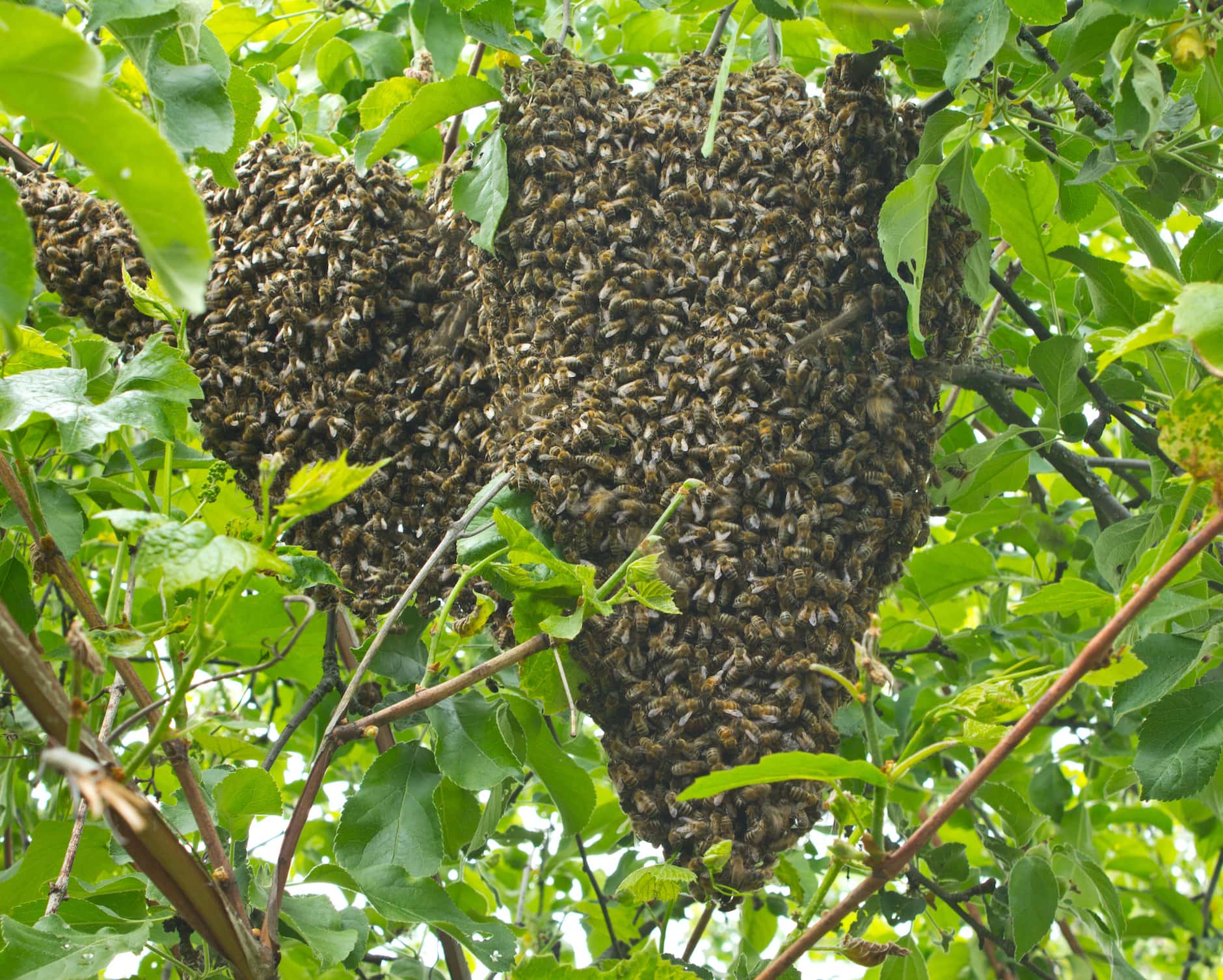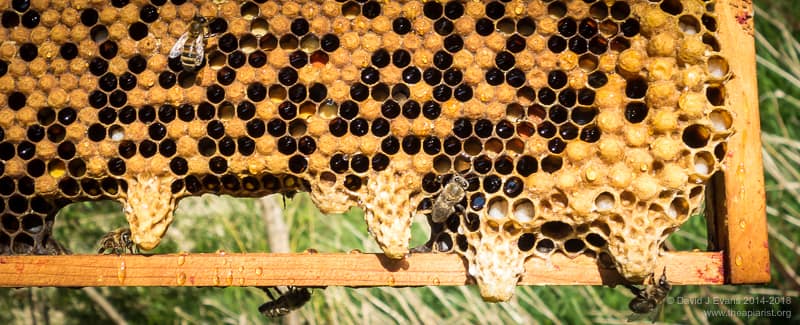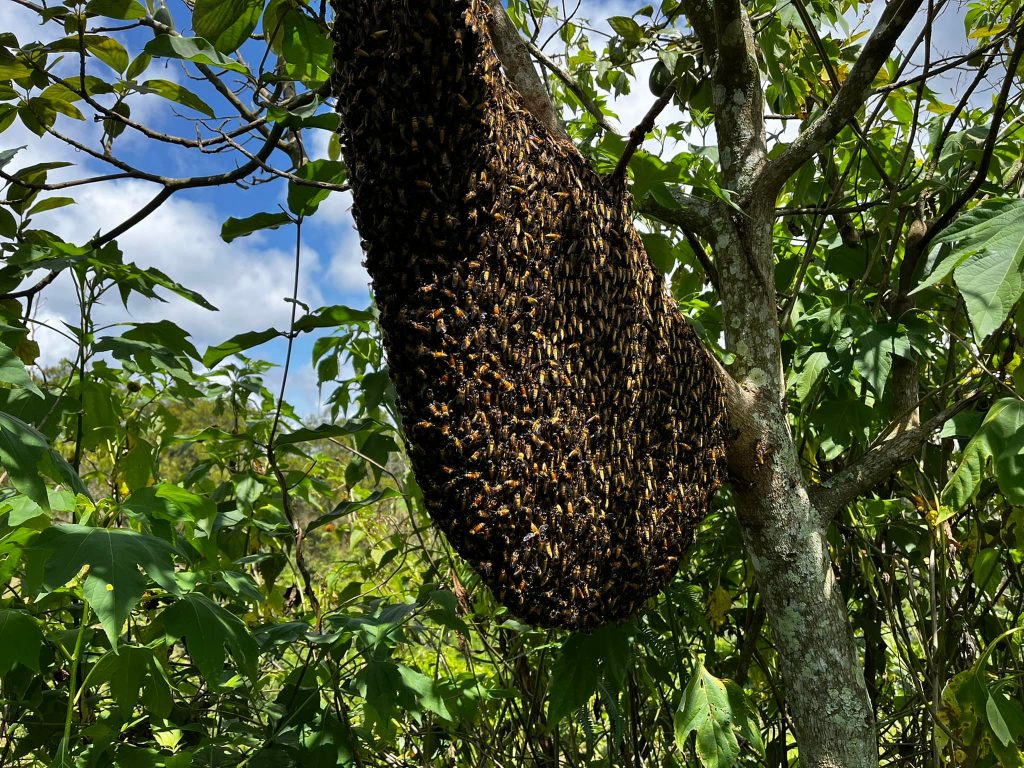
Want to learn how to keep bee swarms in check? Look no further! In this article, we’ll explore effective strategies for managing the masses of bees to ensure a harmonious coexistence between humans and these buzzing creatures. From understanding the reasons behind bee swarming to implementing preventive measures, this guide will provide you with all the information needed to maintain a safe and peaceful environment for both bees and humans. So, let’s get started and discover the secrets to managing bee swarms like a pro!

Understanding Bee Swarms
Definition of Bee Swarm
A bee swarm refers to a group or cluster of bees that leave their original hive and gather together in a temporary location while searching for a new permanent home. Swarming is a natural and instinctive behavior of bees, typically triggered when the colony becomes overcrowded or when the performance of the queen declines. Understanding the behavior and reasons behind swarming is crucial for beekeepers to effectively manage their hives and prevent potential issues.
Reasons for Swarming
One of the main reasons bees swarm is due to overcrowding within the hive. As the population of a colony grows, space becomes a limited resource. Bees can sense this congestion and take necessary measures to ensure the survival and expansion of their species. Additionally, the performance of the queen bee plays a vital role in swarm triggers. If the queen becomes less productive or starts to decline in health, the bees may decide to swarm and establish a new colony with a new queen. Seasonal changes, such as the arrival of spring, can also act as a stimulus for swarming, as bees are naturally inclined to reproduce and expand during favorable weather conditions.
Importance of Managing Bee Swarms
Managing bee swarms is crucial for several reasons. Firstly, swarming can lead to a significant loss of bees from the original hive, resulting in a decrease in honey production. This can be detrimental for beekeepers who rely on the honey harvest for their livelihood. Swarming can also pose a risk to the general public, as bees may choose inconvenient locations for their temporary cluster, such as residential areas or public spaces. Furthermore, swarming bees may compete with established colonies for available resources, impacting the overall health and productivity of local bee populations. By understanding and effectively managing bee swarms, beekeepers can prevent these issues and ensure the well-being of both their colonies and the surrounding environment.
Identifying Potential Swarm Triggers
Environmental Factors
Several environmental factors can contribute to the likelihood of a bee swarm. Bees are particularly sensitive to changes in temperature, humidity, and the availability of food sources. A sudden lack of nectar and pollen, extreme weather conditions, or disturbances posed by nearby construction activities can all act as triggers for swarming. Being aware of these external factors can help beekeepers anticipate and take proactive measures to prevent swarming.
Hive Overcrowding
As mentioned earlier, overcrowded hives are a significant trigger for swarming. When the bees run out of space to expand their brood, store honey, or their population exceeds the hive’s capacity, swarming becomes an inevitable response. Monitoring the size of the colony and regularly inspecting the hive’s condition can help beekeepers identify signs of overcrowding and take necessary action to prevent swarming.
Queen Performance
The queen bee’s performance plays a crucial role in maintaining hive stability and preventing swarming. If the queen’s egg-laying rate decreases or she becomes unable to produce sufficient amounts of pheromones, the bees may decide to replace her or swarm to ensure the survival of the colony. Regularly evaluating the queen’s health, fertility, and behavior is essential to prevent swarming triggered by queen-related issues.
Seasonal Changes
Bee swarms are more likely to occur during specific seasons, particularly when the weather becomes favorable for colony growth. Spring, in particular, is a time when bees naturally start to reproduce and expand their population. The availability of resources, warmer temperatures, and longer daylight hours during this period make it an optimal time for swarming events. Beekeepers should be especially vigilant during these seasons and take preventative measures to manage potential swarms.
Preventive Measures
Regular Hive Inspections
Performing regular hive inspections is a crucial practice that allows beekeepers to identify potential swarm triggers early on. By inspecting the hive for signs of overcrowding, assessing the queen’s performance, and monitoring the availability of resources, beekeepers can take preventive measures before swarming occurs. These inspections also provide an opportunity to address any other potential issues within the hive.
Proper Hive Maintenance
Maintaining a healthy and well-managed hive is instrumental in preventing swarming. This includes ensuring adequate ventilation, providing a suitable brood box size, and regular cleaning and sanitization practices. By creating an optimal environment within the hive, beekeepers can minimize the chances of swarming. Regular maintenance also helps in keeping the bees healthy and productive.
Providing Adequate Space
One of the primary reasons for swarming is the lack of space within the hive. Beekeepers can avoid this issue by providing additional supers or adding extra frames to accommodate the growing population. This ensures that the bees have enough room to expand their brood and stores, reducing the urge to swarm in search of more space.
Managing Queen Population
The performance of the queen bee greatly impacts the likelihood of swarming. Beekeepers can prevent swarming triggered by queen-related issues by regularly replacing aging or declining queens with young, productive ones. This proactive measure ensures a well-functioning colony and reduces the risk of swarming due to queen problems.
Creating Swarm Traps
Understanding Swarm Trap Concept
Swarm traps are a useful tool for beekeepers to capture and manage swarms. These traps mimic an ideal nesting site for swarming bees, attracting them to enter the trap instead of choosing inconvenient locations. Understanding the concept of swarm traps involves knowing the natural preferences of swarming bees and utilizing suitable materials and designs to create an enticing trap.
Selecting Optimal Locations
Choosing the right locations for swarm traps is crucial for their effectiveness. Ideal locations include areas with high bee activity, near established colonies, and where swarms are likely to pass through. Beekeepers should consider factors such as visibility, accessibility, and natural attractants like flowers or water sources when selecting the optimal locations for their swarm traps.
Building and Setting Up Swarm Traps
Building a swarm trap involves using materials like wood, plywood, or plastic to create a sturdy and bee-friendly structure. The trap should include features such as a entrance tunnel, a ventilated roof, and frames with comb guides to attract the swarming bees. Setting up the trap involves securing it in the selected location, ensuring it is stable and properly positioned to maximize its effectiveness in capturing swarms.
Monitoring and Relocating Swarms
Once a swarm is captured in a trap, it is essential to monitor it regularly to determine its health and readiness for relocation. Beekeepers should ensure that the swarm has sufficient food stores, a healthy queen, and a suitable brood size before transferring it to a permanent hive. Regular monitoring allows for timely intervention and prevents any challenges or potential issues during the transition from the trap to the hive.

Swarm Control Techniques
Splitting Colonies
One effective technique to control swarming is to split colonies. This involves creating two separate colonies by physically dividing the original hive into two. By doing so, the bees are provided with extra space, and the urge to swarm is diminished. Splitting colonies also serves as a swarm prevention method by allowing beekeepers to manage the population and resources more effectively.
Artificial Swarm
An artificial swarm is a technique that involves replicating the natural swarming process under controlled conditions. This technique requires identifying the queen bee, moving her to a new hive along with a portion of the original colony and resources, and leaving the remaining bees to requeen themselves. By creating an artificial swarm, beekeepers can prevent or manage swarming events more efficiently.
Queen Clipping
Clipping the queen’s wings is a method used by beekeepers to effectively control swarming. This involves gently trimming a small portion of the queen’s wings, limiting her ability to fly long distances and reducing the chances of swarming. This technique allows the hive to maintain its queen, preventing the disruption caused by the loss of the queen during a swarm.
Queen Excluder Usage
Queen excluders are devices placed between the brood boxes and supers within the hive, preventing the queen from accessing the honey supers. By confining the queen to the brood area, beekeepers can control the colony’s brood size, reduce congestion, and minimize the chances of swarming. Queen excluders can be a valuable tool in managing bee swarms and maintaining hive productivity.
Establishing Hive Hygiene
Regular Cleaning Practices
Maintaining hive hygiene is essential for the overall health and well-being of the colony. Regular cleaning practices involve removing debris, dead bees, and excess honey from the hive. This helps prevent the spread of diseases and pests and ensures that the bees have a clean and safe environment to thrive in. Beekeepers should establish a routine for hive cleaning to minimize the risk of swarming caused by poor hive hygiene.
Managing Hive Diseases
Diseases can weaken the colony and increase the likelihood of swarming. Beekeepers should have a comprehensive understanding of common hive diseases and take proactive measures to prevent and manage them. This includes regular disease inspections, prompt treatment when necessary, and implementing preventative measures such as hygienic bee breeding and spacing out frames to inhibit disease transmission.
Pest Control Measures
Pests, such as varroa mites and wax moths, can have a significant impact on the health and vitality of a colony. Implementing pest control measures is crucial in preventing swarming triggered by infestations. Using integrated pest management techniques, such as monitoring, chemical treatments, and physical barriers, beekeepers can effectively manage pests and reduce the risk of swarming caused by invasions.
Maintaining Healthy Bee Population
Maintaining a healthy bee population is vital in preventing swarming. Beekeepers should prioritize practices that support the overall well-being of their bees, such as providing access to clean water sources, enriching their diet with diverse and abundant nectar sources, and minimizing stress factors. By promoting a healthy and robust bee population, beekeepers can reduce the likelihood of swarming and maintain hive stability.

Natural Deterrents and Repellents
Planting Bee-Repellent Vegetation
Selecting and planting bee-repellent vegetation around the apiary or in areas where swarms are undesirable can help deter bees from settling in those locations. Certain plants, such as garlic, mint, eucalyptus, and lemongrass, are known to repel bees due to their strong scents and tastes. By strategically incorporating these plants into the surrounding environment, beekeepers can create a deterrent for swarming bees.
Utilizing Natural Essential Oils
Natural essential oils can be used as repellents to discourage bees from settling in unwanted areas. Oils such as citronella, lavender, peppermint, and tea tree have been found to be effective at keeping bees away. By applying these oils to strategic locations or creating barrier sprays, beekeepers can deter swarms from inconveniencing people or interfering with certain activities.
DIY Repellent Mixes
Beekeepers can create their own repellent mixes using ingredients found in their kitchen or garden. Simple solutions like vinegar and water sprays, chili powder mixtures, or citrus peels can be applied to areas where swarming bees need to be deterred. These natural repellents provide beekeepers with a non-harmful and environmentally friendly option for managing swarms.
Physical Barriers
Creating physical barriers can prevent swarming bees from accessing certain areas. This can be achieved by installing fine mesh screens, netting, or fences around locations where swarms are undesired. By obstructing the bees’ flight paths and limiting their access, physical barriers effectively deter swarms and protect both bees and humans from potential conflicts.
Professional Beekeeping Services
Importance of Expert Assistance
Seeking professional beekeeping services is crucial for beekeepers who may require specialized knowledge or expertise in managing swarms. Professional beekeepers have experience in swarm prevention and control techniques and can provide valuable advice tailored to specific situations. Their expertise ensures the effective management of swarms and reduces the risk of potential issues arising from improper handling.
Hive Management Consultations
Beekeepers can benefit from hive management consultations provided by professional beekeepers. These consultations involve expert assessment of the beekeeping operation, identification of potential swarm triggers, and personalized advice on swarm prevention and control methods. Consulting with professionals allows beekeepers to optimize their practices and ensure the long-term success and stability of their hives.
Hiring Swarm Removal Professionals
In situations where swarms have already formed and need to be relocated, hiring swarm removal professionals is a wise choice. These professionals have the necessary equipment, knowledge, and experience to safely capture and relocate swarms without causing harm to the bees or the environment. Their expertise ensures the successful removal and management of swarms, minimizing potential risks associated with swarming bees.

Education and Training Programs
Beekeeping Courses and Workshops
Participating in beekeeping courses and workshops is an excellent way for beekeepers to enhance their knowledge and skills in swarm prevention and management. These educational programs cover various topics related to beekeeping, including swarm control techniques, hive maintenance, and disease management. Beekeepers can learn from experienced instructors and gain practical insights to effectively manage their hives and prevent swarming.
Online Resources and Communities
The internet provides an abundance of online resources and communities dedicated to beekeeping. Beekeepers can access informative articles, videos, forums, and social media groups where they can connect with fellow beekeepers and share their experiences and knowledge. Online resources offer a convenient and accessible platform for beekeepers to expand their understanding of swarm prevention and management techniques.
Certification Programs
Obtaining certification in beekeeping is another valuable way to augment one’s knowledge and expertise in swarm prevention and control. Several organizations offer certification programs that cover various aspects of beekeeping, including swarm management. These certification programs provide comprehensive training and assessment, ensuring beekeepers have the necessary skills and competency to effectively manage their hives and prevent swarming.
Promoting Bee Conservation
Creating Bee-Friendly Environments
Beekeepers can contribute to bee conservation efforts by creating bee-friendly environments both within their apiaries and in their surrounding areas. This includes planting diverse and pesticide-free flowers, providing a water source, and creating nesting sites for wild bees. By offering a conducive habitat, beekeepers can support the overall health and population growth of bees while minimizing the risk of swarming events.
Supporting Local Pollinator Initiatives
Participating in and supporting local pollinator initiatives can greatly contribute to bee conservation. These initiatives focus on creating awareness about the importance of pollinators, implementing conservation strategies, and providing resources and support for beekeepers. By actively engaging with such initiatives, beekeepers can collaborate with like-minded individuals and organizations to protect and preserve bee populations while managing swarming effectively.
Participating in Beekeeping Associations
Beekeeping associations offer a platform for beekeepers to come together, exchange knowledge, and collaborate on bee conservation efforts. By participating in these associations, beekeepers can stay updated on the latest swarm prevention techniques and exchange valuable insights with experienced beekeepers. The collective efforts of beekeeping associations play a significant role in preserving bee populations and minimizing the impact of swarming events.
Spreading Awareness and Education
One of the most impactful ways beekeepers can contribute to bee conservation and swarm management is by spreading awareness and education. By educating the general public about the importance of bees, the natural behavior of swarming, and how to respond to swarms safely, beekeepers can help mitigate misconceptions and promote responsible swarm management practices. Through workshops, talks, and community engagement, beekeepers can empower others to play an active role in protecting bees and managing swarms effectively.
In conclusion, understanding bee swarms is crucial for beekeepers to effectively manage their hives and prevent potential issues. Identifying potential swarm triggers, implementing preventive measures, and utilizing swarm control techniques are essential steps in maintaining hive stability. Additionally, establishing hive hygiene, utilizing natural deterrents, and seeking professional beekeeping services contribute to effective swarm management. Education and training programs, along with promoting bee conservation efforts, play a vital role in ensuring the long-term health and sustainability of bee populations. By employing these strategies and practices, beekeepers can successfully keep bee swarms in check while maintaining the productivity and resilience of their colonies.
